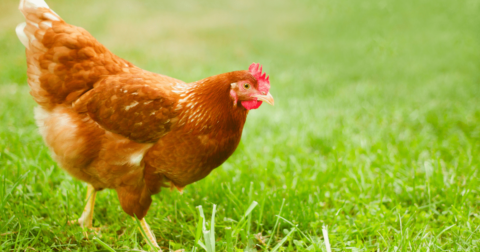News
Costco Chicken Processing Plant Keeps Failing Tests for Salmonella
Food•5 min read
Explainer
You might think "free-range" meat comes from happy animals but in reality, the label is no guarantee the farm meets any animal welfare standards.


Words by Björn Ólafsson
When the average person thinks of “free-range” meat, they tend to picture farms with grassy fields speckled by beautiful black and white spotted cows, roaming and grazing as they please. Yet even though you might assume the animals are treated well, “free-range” labels on meat or eggs don’t guarantee that animals were raised humanely.
In everyday usage, “free-range” refers to animals that have free access to roam the outdoors, especially to the fields and grasslands that suit their biological needs. Unfortunately, on many “free-range” farms, this definition rarely matches reality.
According to the USDA, meat qualifies as “free-range” if the producers attest that the animals have continuous, free access to the outdoors for more than 50 percent of their lives.
However, the Food Safety and Inspection Service does not provide a clear definition of the term “free-range,” or related terms like cage-free, pasture-raised, free-roaming or not confined. This gives manufacturers broad leeway in how they raise animals — the animals could spend nearly all of their time outdoors or they could be kept primarily in cramped conditions with some limited access point to small outdoor areas that may be hard to access.
Farms tend to have different types of free-range farm setups. Some are entirely outdoors, while others are a mix of indoors and outdoors, and still others have a small fenced area for animals to peek out at points during the day. “Free-range” farms may be any size.
Most of the time, the phrase “free-range” is used as a marketing term, not as a guarantee of any particular kind of construction.
Chickens who have some access to the outdoors can be labeled as “free-range,” although the length of outdoor time and type of outdoor space (from gravel to grass) can vary widely.
Naturally, chickens love the outdoors — albeit usually with some structural protection from predators — and hate being crammed together with other animals. Chickens are even known to play with other birds, running, jumping, wrestling and frolicking with each other in outdoor areas.
Free-range eggs are eggs that have been laid by free-range hens.
Some turkey farms raise their animals in free-range environments, although this is not common. Turkeys are normally raised inside massive warehouses, crammed in beak-to-beak and tail-to-tail.
All beef cows are raised with some access to the outdoors and varying amounts of roaming time. Cows enjoy grazing on fresh grass and playing with their friends and family.
Sheep, goats and other large mammals can be raised free-range. Sheep are actually the most likely species to be raised free-range, although they still face other ethical problems, such as branding, tail docking, unpleasant shearing, inhumane slaughter and poor transportation.
Free-range farms can offer some welfare advantages over confined feeding operations or factory farms but because there is little to no federal oversight of these claims, it’s impossible to know for sure just based on the label alone.
From an animal welfare standpoint, the research is clear that animals prefer time outdoors, more space to roam and better food and water. Yet the term “free-range” is not a guarantee that a farm follows robust animal welfare practices.
For starters, though the USDA does require written documentation from farms, as Jessica Scott-Reid writes for Vox, the “claims aren’t closely scrutinized.” The USDA has been flooded with a myriad of animal welfare complaints for products labeled “humane,” but has done very little to address the problem — primarily adjusting the type of documentation required rather than on-site verification. The Animal Welfare Institute reviewed many of the claims submitted to the USDA for products purporting to be from “humanely raised” animals, and found that around half of them lacked sufficient reasoning for their claim.
Farmed animals raised “free-range” may also still experience gaps in their welfare. Animals experience pain during many procedures permitted on free-range farms, including branding, dehorning and tail docking. Animals may still be fed diets meant to fatten them up at an unnatural rate, harming their bodies and causing injury. And finally, the method of slaughter can still be quite inhumane, with many animals conscious before the moment of death.
If you want to make sense of these food labels, an independent third-party label at least offers the potential for oversight but there are a wide variety of standards. Here is what several of them mean.
Cow meat, pig meat, goat meat and dairy products can qualify as American Grassfed if they are fed a 100 percent grass-fed diet, raised on pasture without confinement, never given antibiotics or hormones and originate from family farms.
Animal Welfare Approved is a certification given by A Greener World, a nonprofit farm assurance program. To qualify, animals must be reared on pasture or ranges, must come from independent farmers and must have high standards of animal welfare.
For an animal product to be certified Organic by USDA, they must be raised in conditions that accommodate natural behaviors, fed organic feed and not administered hormones or unnecessary antibiotics (note: Organic farm animals who require treatment with antibiotics are often treated and sold to a nearby conventional farm).
After pressure from animal welfare groups and the Organic Trade Association, USDA published new animal welfare standards for certified Organic meat, poultry and eggs in October 2022. Groups pushing for the new rules aim to close loopholes that permit limited outdoor access for animals and other conditions that are detrimental for farm animal welfare.
There exist several third-party certifications for eggs, each of which has its own criteria and standards.
Free-Range eggs are laid by chickens raised without cages and with some access to the outdoors, although exact standards are only corroborated by a third-party certifier. Eggs that are American Humane Certified free-range come from chickens with access to nest spaces and “adequate” indoor space.
Neither label guarantees humane treatment of the chickens, painless slaughter or any other ethical protections.
Pasture-raised eggs should come from chickens that spend most of their time outdoors. If an egg is certified as pasture-raised and American Humane, the chickens have over 100 square feet of space outdoors during daytime, plenty of water and food and satisfy certain other criteria.
Free-range products with a Certified Humane Raised and Handled sticker must come from chickens who have been given nutritious feed, an appropriate environment, ample space, perches and nests, as well as access to the outdoors.
Products with a Certified Humane Raised and Handled sticker to corroborate their pasture-raised status must come from chickens who have been given nutritious feed, an appropriate environment, ample space, perches and nests, as well as being outdoors in approved pasture for a minimum of six hours a day.
Under most certifications, chickens have access to more space, sunlight and the outdoors, which are undoubtedly improvements over the standard system of factory farming that typically use battery cages that provide chickens with the amount of space equivalent to a piece of printer paper.
However, the following practices are still common. Male chicks who are useless to farmers are usually killed right away, including by being ground alive. The hens are usually killed long before the end of their natural lifespan too, as soon as they are no longer considered sufficiently productive.
Even the best labeling standards, like Humane Raised or Certified Humane, still slaughter both very young and older animals when they are not profitable.
Consumers who care about animal welfare are often confused by the various labels at the grocery store — and that’s with good reason. Many labels lack enforcement or rely on farms to self-report compliance. Choosing third-party labeling is better than nothing, but according to a 2021 survey by Farm Forward, all labels fall short of consumers’ expectations.
One way for consumers to reduce the amount of animal suffering and environmental impacts associated with what they eat is to transition to a plant-rich diet. For more information on how to get more plants on your plate, see our Take Action guide.